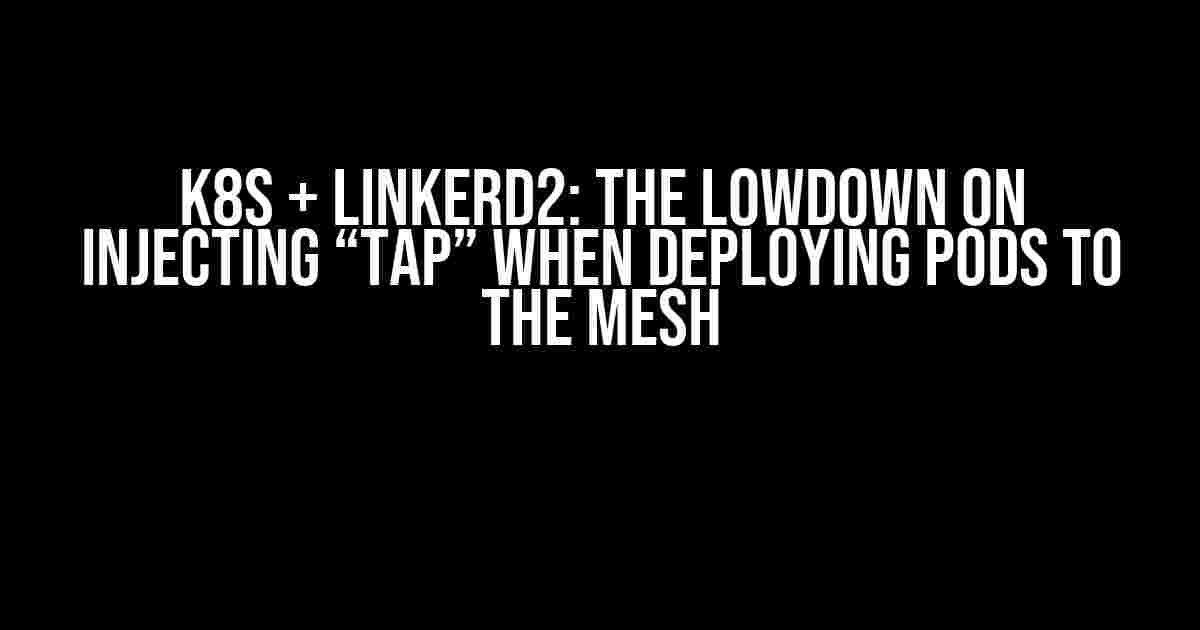Are you ready to take your Kubernetes (K8S) game to the next level with Linkerd2? If so, you’re probably wondering about the implications of injecting “tap” when deploying pods to the mesh. In this article, we’ll dive into the world of K8S and Linkerd2, exploring the benefits and potential pitfalls of including “tap” in your deployment strategy.
What is Linkerd2?
Before we dive into the nitty-gritty of injecting “tap”, let’s take a step back and introduce Linkerd2. Linkerd2 is a lightweight, open-source service mesh that provides a powerful way to manage and observe your Kubernetes applications. It’s designed to be highly extensible, scalable, and resilient, making it an ideal choice for large-scale K8S deployments.
What does Linkerd2 do?
Linkerd2 provides a range of features that make it an essential tool for K8S deployments. Some of its key features include:
- Service discovery and routing
- TLS encryption and mutual authentication
- HTTP/2 and gRPC support
- Distributed tracing and request logging
- Service mesh visualization and monitoring
What is “tap” in Linkerd2?
In Linkerd2, “tap” refers to a special type of pod that allows you to tap into the traffic flowing through the mesh. By injecting “tap” into your deployment, you can gain visibility into the traffic flowing between your pods, allowing you to debug and troubleshoot issues more effectively.
How does “tap” work?
When you inject “tap” into your deployment, Linkerd2 creates a new pod that mirrors the traffic flowing through the mesh. This allows you to inspect and analyze the traffic in real-time, without affecting the performance of your application.
apiVersion: v1
kind: Pod
metadata:
name: my-tap
spec:
containers:
- name: tap
image: linkerd/linkerd-tap:stable
args:
- --tap
- --mesh
The Benefits of Injecting “tap”
So, why would you want to inject “tap” into your deployment? Here are just a few benefits:
- Improved debugging and troubleshooting capabilities
- Enhanced visibility into traffic flowing through the mesh
- Simplified troubleshooting and issue resolution
- Reduced mean time to detect (MTTD) and mean time to resolve (MTTR)
The Risks of Injecting “tap”
While injecting “tap” can provide valuable insights into your mesh traffic, there are some potential risks to consider:
- Performance overhead: Injecting “tap” can introduce additional latency and overhead into your mesh traffic.
- Resource consumption: Tap pods can consume additional resources, including CPU, memory, and network bandwidth.
- Security risks: Allowing unauthorized access to tap data can compromise the security of your mesh.
Best Practices for Injecting “tap”
To get the most out of injecting “tap” into your deployment, follow these best practices:
- Use “tap” judiciously: Only inject “tap” into specific pods or services where visibility is critical.
- Configure “tap” carefully: Ensure that tap pods are properly configured to minimize performance overhead and resource consumption.
- Monitor and analyze tap data: Regularly review tap data to identify trends, anomalies, and potential issues.
- Implement security controls: Ensure that tap data is properly secured and access is restricted to authorized personnel.
Conclusion
In conclusion, injecting “tap” into your Linkerd2 deployment can provide valuable insights into the traffic flowing through your mesh. However, it’s essential to be aware of the potential risks and take steps to mitigate them. By following best practices and configuring “tap” carefully, you can unlock the benefits of tap data while minimizing the overhead and security risks.
| Benefits | Risks | Best Practices |
|---|---|---|
| Improved debugging and troubleshooting | Performance overhead | Use “tap” judiciously |
| Enhanced visibility into mesh traffic | Resource consumption | Configure “tap” carefully |
| Simplified troubleshooting and issue resolution | Security risks | Monitor and analyze tap data |
By following the guidelines outlined in this article, you’ll be well on your way to unlocking the full potential of Linkerd2 and injecting “tap” into your deployment with confidence.
Final Thoughts
As you continue to explore the world of K8S and Linkerd2, remember that injecting “tap” is just one part of the puzzle. By combining “tap” with other Linkerd2 features, such as service mesh visualization and request logging, you can create a powerful Observability platform that helps you build faster, more resilient applications.
So, what are you waiting for? Start exploring the world of Linkerd2 and injecting “tap” today!
Happy coding!
Frequently Asked Question
Get the lowdown on deploying pods to Linkerd2’s mesh with K8S and the impact of injecting “tap”!
Will injecting “tap” slow down my pod deployments in Linkerd2’s mesh?
The good news is that injecting “tap” won’t significantly slow down your pod deployments. In fact, Linkerd2 is designed to handle Tap injection with minimal overhead, so you can enjoy the benefits of Tap without sacrificing deployment speed.
Is injecting “tap” compatible with all kinds of pods in Linkerd2’s mesh?
While injecting “tap” is generally compatible with most pod types, there are some exceptions. For example, pods that use certain types of proxy or networking configurations might not work well with Tap injection. Be sure to check the Linkerd2 documentation for specific guidance on supported pod types.
Can I use “tap” to monitor my pods in Linkerd2’s mesh without injecting it?
Unfortunately, no. To take advantage of Tap’s monitoring capabilities, you need to inject it into your pods. This allows Linkerd2 to capture and analyze traffic data, providing you with valuable insights into your pod behavior. Injecting Tap is a straightforward process, and the benefits are well worth the minor additional configuration effort.
Will injecting “tap” affect my pod resource usage in Linkerd2’s mesh?
The impact of injecting “tap” on pod resource usage is minimal. Linkerd2’s Tap is designed to be lightweight and efficient, so you won’t notice a significant increase in CPU, memory, or other resource utilization. You can inject Tap without worrying about resource constraints, and still enjoy the benefits of enhanced visibility and monitoring.
Are there any specific configuration requirements for injecting “tap” into my pods in Linkerd2’s mesh?
Yes, you’ll need to configure your pods to accept Tap injection. This typically involves adding a few lines of configuration to your pod spec or Helm chart. Don’t worry, the process is well-documented, and the Linkerd2 community provides plenty of resources to help you get started. Just follow the official guides, and you’ll be up and running in no time!


